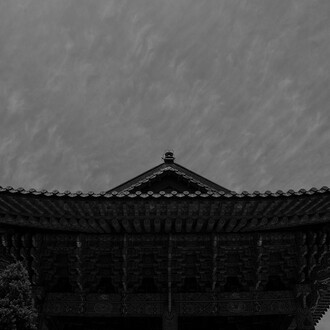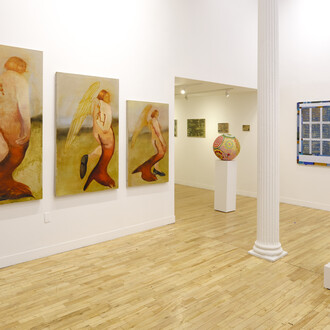One immediately feels at home with Nancy Prager, this very gracious, graceful and spirited lady. Our three hours flew with as we spoke mostly about things philosophical and metaphysical, sharing experiences broad in range. The World Trade Center attack was gone and over again, this being the month of November, with the memories still very fresh. Nancy had been below the Towers during the devastation, trapped in the subway for two hours during their collapse. The passengers, could smell the smoke but knew nothing of the events going on above them. I could see this has had a profound effect upon Nancy, changing direction, as evident in the newer material done after Sept. 11.
Nothing I had been told about the works of art prepared me for the wealth of creative energy I saw at Nancy’s Southhampton home/studio that afternoon during the Christmas Holiday week. A tour of the house, room to room, brought to life over thirty years of Nancy’s paintings. Large and small statements bright with color, contrast and movement. Three-dimensional works, watercolors, oils and multi-media pieces all took their rightful positions on the walls of the artist’s home.
During the course of my stay, I learned that Nancy had been painting since childhood. After graduating Syracuse University, she attended Cooper Union. She has shown extensively in Manhattan and won the prestigious Le Prix de Paris award early in her career during her first major exhibition in Europe in 1975. Many important museum and collections own her works. Each work communicated clearly it’s visual story, individually competing for my attention. Complete sentences of visual thought. Rich in symbolism, metaphor and personal iconography, all combining a balance and definition of line that delivered classical and well-developed personal statement.
By the use of softly muted forms Nancy finds light from an unknown source — a technique used by other accomplished Impressionists. Working toward an abstracted field, Nancy’s work stated a rich personal atmosphere — a statement about life that profiles her lifetime journey as an artist. Punctuating each segment in a her own distinct abstract impressionism, Nancy embraces her internal movement and reactions. They are released on canvas, resulting in a poignant and fresh picture of the moment she is sharing. Landscapes, portraits, and scenes all side-stepping and superficial. The hue of colors, pattern and form allow the emotion and movement in the artists’ eye to be absorbed by the viewer, never insisting that the viewer see as Nancy has seen, but opening the door artistically for the osmosis to occur between viewer and artist. There is an alchemy of thought, a chemistry that occurs in her paintings. The form, color, light and subject are given animation in a non-obtrusive way. Great sophistication is achieved in a very simple and classic approach to subject and medium.
With a sensuality that is not blatant, Nancy sculpts the icon — the anima — of the feminine body in paint. Gentle vibrant color is sometimes employed and somber shadows are invoked for the purpose of creating mood. When warm pastels, such as peach, rose, light sapphire and a slate gray are applied to the works, subtle emotion is conveyed in the depiction of this nude trilogy (Life and Death). Possibly the self is seen catching a glimpse of its own existence? The nude reclining torso in bright yellow with bright flowers, red, whit and blue becomes one with an earthy background of burnished color. No special emphasis is placed here other than the statement of how good this feels. In Tarot, the man with his crown on is a king in repose. Drifting into the reflection of his thoughts, one notes here the space between reality of the reflection and the haunting undercurrent he is experiencing.
Moonlight Escapade features two women in a doorway. One standing, one sitting turned away from the other. All around them turns toward the darkness, although it appears to be waiting for a turbulence needing to be brought on by action. This painting is particularly calms and set in the moment. Time, space and conditions of life have not yet been set into action. Possibly they are recovering from some former event — both parties taking this time to see a perspective and share an experience in whatever light is available. Nothing is spoken, so that this piece of life stands on it’s own outside of time.
In Erudite, A woman is reading a book. Her back drop is a fabric of white with bright red flowers. The black of her outfit is emphasized by the color. Once again there is a tranquility in this repose. But the accent of yellow at the bottom of her pant leg and the dancing flowers tell of the mental state of the reader. Active vibrant and happy. It seems to be good to read one’s book on a warmish day while sitting on your front porch.
(By Jamie Ellin Forbes, Fine Art magazine)

















